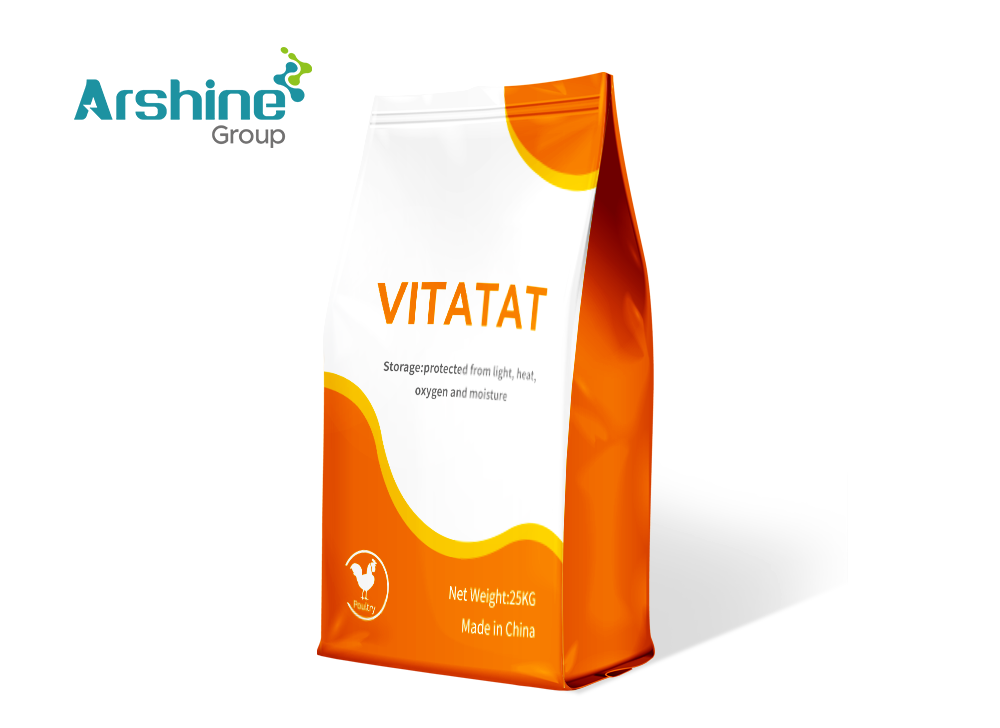
CAS number:
Molecular formula:
molecular weight:
Chemical structure:
COMPOSITION:
Each 100gm powder contain-
Vitamin B complex:( Vitamin B1-2000 mg; Vitamin B2-4000 mg; Vitamin- B6- 1500 mg; Vitamin B12- 10 mg) ,Vitamin C – 500 mg, Elemental Calcium –400 mg; Copper Sulphate- 20 mg; Cobalt Sulphate- 10 mg and other Minerals(Fe, Selenium) – 100mg - Feed Grade
DESCRIPTION
Vitatat is composition of Vitamin and Minerals like vitamin B complex; vitamin C, Calcium, , Copper, Cobalt and other minerals - Feed Grade. Vitamins are essential organic nutrients, required in small amounts. Different classes of vitamins include fat-soluble vitamins that are stored in tissues (A, D, E and K); water-soluble vitamins are the one that are not stored in tissues and there should be a constant supply (B Complex vitamins and C). The B vitamins include vitamin thiamin, riboflavin, niacin, pantothenic acid, pyridoxine, biotin, folic acid, and cyanocobalamin. The B vitamins are involved in many metabolic functions, including energy metabolism. A vitamin premix is typically used to compensate for the fluctuating levels of vitamins found naturally in food and to assure adequate levels of all vitamins. Thiamine (Vitamin B1) is necessary for proper carbohydrate metabolism. The deficient birds show anorexia, loss of weight, ruffled feathers, dropping of wings and paralysis of muscles.The birds sit on flexed legs and draw back the head in a 'star-gazing' position. It is found in abundance in rice polish, wheat bran and cereal grains. Riboflavin (Vitamin B2) is part of enzyme systems so plays a vital role in metabolism. The deficiency causes diarrhoea and “curled toe paralysis” in birds between the first and second week of age.The affected birds walk upon their hocks with the aid of their wings. In adult birds, decreased egg production, increased embryonic mortality and dead in shell chicks, with dwarfing and clubbing down feathers are seen.Embryo mortality reaches a peak between 18 to 20 days of incubation. Grasses and brewer’s yeast are rich source of this vitamin. Pyridoxine (Vitamin B6) is necessary for proper metabolism of amino acids. Due to deficiency, spasmodic convulsions and jerky movements are seen in sick birds. The bird should be fed cereal grains, yeast and alfalfa meal. Cyanocobalamin (Vitamin B12) is involved with nucleic acid synthesis, carbohydrate and fat metabolism and methyl synthesis. This is found in all foods of animal origin.Its deficiency shows slowed growth, poor feed utilisation and reduced hatchability. Embryonic mortality reaches peak on the 17th day of incubation.Myotrophy of legs and haemorrhages in the allantois of the embryo may be seen. Fish meal, milk products and animal proteins are sources of vitamin B12. Vitamin C also known as Ascorbic acid is called an antioxidant compound with a chemical formulation. It has antioxidant and anti-inflammatory effects. Therefore, it is effective for poultry in cases of inflammation, oxidative stress, and infection. Ascorbic acid is not an essential nutrient for poultry as it can be synthesized from poultry through the biosynthetic pathway. The use of ascorbic acid to support poultry animals in adverse conditions, especially under heat stress conditions, is essential; it is one of the important processes during the rearing period. Furthermore, the use of ascorbic acid in the poultry’s diet helps improve poultry’s performance and health. Minerals are vital for normal growth and development in poultry, such as bone formation and body processes such as enzyme activation. Calcium and phosphorus are essential for the formation and maintenance of the skeleton. Calcium is important in egg shell formation, and also required for blood clotting. Copper is a micromineral that makes up several enzymes involved in oxidation-reduction processes. In addition, it also plays a fundamental role in the functioning of blood cells, skin pigmentation, and the formation of bones and nerves. Cobalt is a component of vitamin B12 (cyanocobalamin), which is involved in the formation of red blood cells and nerve cell functions.
INDICATION
Ø Prevent disease by its antioxidant properties
Ø Plays vital role to improve by enhanced immunity
Ø Improves reproductive performance
Ø Increases feed consumption, weight gain and feed conversion ratio(FCR)
Ø Prevent any kind of stress, paralysis, inflammation of skin etc.
Ø Prevent thin or soft-shelled eggs, softening of beak, feet, and keel, bent or malformation of beak
DOSAGE & ADMINISTRATION
Poultry : 100gm / 50 kg feed
Large animal: 1gm / 2 Kg feed
SHELF-LIFE
24 months of manufacturing date.
PACK SIZE
25 Kg Carton/ Pack.
STORAGE
Store in a cool & dry place, protect from light & moisture.
Keep out of the reach of children.